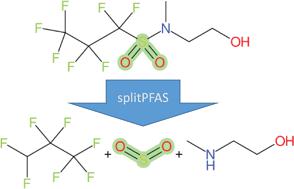当前位置:
X-MOL 学术
›
Environ. Sci.: Processes Impacts
›
论文详情
Our official English website, www.x-mol.net, welcomes your
feedback! (Note: you will need to create a separate account there.)
Exploring open cheminformatics approaches for categorizing per- and polyfluoroalkyl substances (PFASs).
Environmental Science: Processes & Impacts ( IF 4.3 ) Pub Date : 2019-09-24 , DOI: 10.1039/c9em00321e Bo Sha 1 , Emma L Schymanski 2 , Christoph Ruttkies 3 , Ian T Cousins 1 , Zhanyun Wang 4
Environmental Science: Processes & Impacts ( IF 4.3 ) Pub Date : 2019-09-24 , DOI: 10.1039/c9em00321e Bo Sha 1 , Emma L Schymanski 2 , Christoph Ruttkies 3 , Ian T Cousins 1 , Zhanyun Wang 4
Affiliation

|
Per- and polyfluoroalkyl substances (PFASs) are a large and diverse class of chemicals of great interest due to their wide commercial applicability, as well as increasing public concern regarding their adverse impacts. A common terminology for PFASs was recommended in 2011, including broad categorization and detailed naming for many PFASs with rather simple molecular structures. Recent advancements in chemical analysis have enabled identification of a wide variety of PFASs that are not covered by this common terminology. The resulting inconsistency in categorizing and naming of PFASs is preventing efficient assimilation of reported information. This article explores how a combination of expert knowledge and cheminformatics approaches could help address this challenge in a systematic manner. First, the “splitPFAS” approach was developed to systematically subdivide PFASs (for eventual categorization) following a CnF2n+1–X–R pattern into their various parts, with a particular focus on 4 PFAS categories where X is CO, SO2, CH2 and CH2CH2. Then, the open, ontology-based “ClassyFire” approach was tested for potential applicability to categorizing and naming PFASs using five scenarios of original and simplified structures based on the “splitPFAS” output. This workflow was applied to a set of 770 PFASs from the latest OECD PFAS list. While splitPFAS categorized PFASs as intended, the ClassyFire results were mixed. These results reveal that open cheminformatics approaches have the potential to assist in categorizing PFASs in a consistent manner, while much development is needed for future systematic naming of PFASs. The “splitPFAS” tool and related code are publicly available, and include options to extend this proof-of-concept to encompass further PFASs in the future.
中文翻译:

探索开放式化学信息学方法,对全氟烷基物质和多氟烷基物质(PFAS)进行分类。
由于全氟烷基物质和多氟烷基物质(PFAS)具有广泛的商业适用性,并且引起越来越多的公众对其不利影响的关注,因此,它们是一大类引起人们广泛关注的化学品。2011年推荐了PFAS的通用术语,包括许多具有相当简单分子结构的PFAS的广泛分类和详细命名。化学分析的最新进展已使人们能够识别该通用术语未涵盖的各种PFAS。在PFAS的分类和命名中导致的不一致导致阻止了对已报告信息的有效吸收。本文探讨了专家知识和化学信息学方法相结合如何能够以系统的方式帮助应对这一挑战。第一的,n F 2 n +1 –X–R模式分为各个部分,特别关注4种PFAS类别,其中X为CO,SO 2,CH 2和CH 2 CH 2。然后,测试了基于本体的开放式“ ClassyFire”方法在基于“ splitPFAS”输出的原始和简化结构的五种情况下对PFAS进行分类和命名的潜在适用性。此工作流程已应用于最新的OECD PFAS列表中的770个PFAS。虽然splitPFAS按预期对PFAS进行了分类,但ClassyFire的结果好坏参半。这些结果表明,开放式化学信息学方法有可能有助于以一致的方式对PFAS进行分类,而未来PFAS的系统命名还需要大量开发。“ splitPFAS”工具和相关代码是公开可用的,并且包括扩展此概念验证的选项,以便将来包含更多的PFAS。
更新日期:2019-09-24
中文翻译:

探索开放式化学信息学方法,对全氟烷基物质和多氟烷基物质(PFAS)进行分类。
由于全氟烷基物质和多氟烷基物质(PFAS)具有广泛的商业适用性,并且引起越来越多的公众对其不利影响的关注,因此,它们是一大类引起人们广泛关注的化学品。2011年推荐了PFAS的通用术语,包括许多具有相当简单分子结构的PFAS的广泛分类和详细命名。化学分析的最新进展已使人们能够识别该通用术语未涵盖的各种PFAS。在PFAS的分类和命名中导致的不一致导致阻止了对已报告信息的有效吸收。本文探讨了专家知识和化学信息学方法相结合如何能够以系统的方式帮助应对这一挑战。第一的,n F 2 n +1 –X–R模式分为各个部分,特别关注4种PFAS类别,其中X为CO,SO 2,CH 2和CH 2 CH 2。然后,测试了基于本体的开放式“ ClassyFire”方法在基于“ splitPFAS”输出的原始和简化结构的五种情况下对PFAS进行分类和命名的潜在适用性。此工作流程已应用于最新的OECD PFAS列表中的770个PFAS。虽然splitPFAS按预期对PFAS进行了分类,但ClassyFire的结果好坏参半。这些结果表明,开放式化学信息学方法有可能有助于以一致的方式对PFAS进行分类,而未来PFAS的系统命名还需要大量开发。“ splitPFAS”工具和相关代码是公开可用的,并且包括扩展此概念验证的选项,以便将来包含更多的PFAS。











































 京公网安备 11010802027423号
京公网安备 11010802027423号